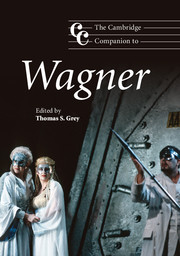Book contents
- Frontmatter
- PART I Biographical and historical contexts
- PART II Opera, music, drama
- 4 The “Romantic operas” and the turn to myth
- 5 Der Ring des Nibelungen: conception and interpretation
- 6 Leitmotif, temporality, and musical design in the Ring
- 7 Tristan und Isolde: essence and appearance
- 8 Performing Germany in Wagner's Die Meistersinger von Nürnberg
- 9 Parsifal: redemption and Kunstreligion
- PART III Ideas and ideology in the Gesamtkunstwerk
- PART IV After Wagner: influence and interpretation
- Notes
- Select bibliography
- Index
4 - The “Romantic operas” and the turn to myth
from PART II - Opera, music, drama
Published online by Cambridge University Press: 28 September 2011
- Frontmatter
- PART I Biographical and historical contexts
- PART II Opera, music, drama
- 4 The “Romantic operas” and the turn to myth
- 5 Der Ring des Nibelungen: conception and interpretation
- 6 Leitmotif, temporality, and musical design in the Ring
- 7 Tristan und Isolde: essence and appearance
- 8 Performing Germany in Wagner's Die Meistersinger von Nürnberg
- 9 Parsifal: redemption and Kunstreligion
- PART III Ideas and ideology in the Gesamtkunstwerk
- PART IV After Wagner: influence and interpretation
- Notes
- Select bibliography
- Index
Summary
In describing Der fliegende Holländer (The Flying Dutchman), Tannhäuser, and Lohengrin as “Romantic operas,” Wagner fell back on a term that he had first used for Die Feen (The Fairies) in 1833–34, but the taxonomical similarity conceals an ideological difference that we can best understand only by briefly examining the conceptual background to these works.
As a literary movement, Romanticism had emerged at the end of the eighteenth century as a protest against the utilitarian, skeptical spirit of the Enlightenment. If Kant had lamented the limits of the powers of reason, Fichte now proceeded to glorify the potentialities of the imagination, opening the floodgates of subjectivity and the irrational, often expressed in the language of Catholic mysticism. At first the movement was apolitical, but the sense of inadequacy induced by the dissolution of the Holy Roman Empire and by the Wars of Liberation of 1813–15 led to a desire to escape from the sordid, reactionary present into a past in which Germany had once been united and strong. One of the leading apologists of the Romantic movement, August Wilhelm Schlegel, summed up the aims of his fellow poets with reference to this feeling of nostalgia: “The poetry of the ancients was that of possession, ours is that of longing.” Sehnsucht, or longing, became a leading motif of Romantic poetry, specifically a longing to re-create the world of the Middle Ages.
- Type
- Chapter
- Information
- The Cambridge Companion to Wagner , pp. 65 - 73Publisher: Cambridge University PressPrint publication year: 2008

